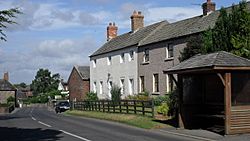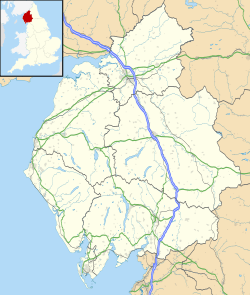Aballava facts for kids
Quick facts for kids Aballava |
|
|---|---|
| Cumbria, England | |

Village centre of Burgh by Sands, and site of Aballava
|
|
| Coordinates | 54°55′19″N 3°03′00″W / 54.922°N 3.050°W |
Aballava (which is now called Burgh by Sands) was a Roman fort built on Hadrian's Wall. This famous wall was a huge barrier that the Romans built across northern England. Aballava was located between two other forts, Petriana (Stanwix) to the east and Coggabata (Drumburgh) to the west.
The fort was about two and a half kilometers south of the Solway Firth. Its main job was to protect the southern end of two important crossing points over the Solway Firth. These crossings, called the Peat Wath and the Sandwath, were also popular routes for raiders in later times. The name 'Aballava' might mean 'apple orchard'.
Exploring Aballava
Aballava was located about nine kilometers west of the Stanwix fort. The fort itself was shaped like a rectangle. It measured about 150 meters from north to south and 120 meters from east to west. This covered an area of about two hectares. We only know for sure where the eastern wall of the fort was.
Historians believe the fort was built over an earlier Roman watchtower. Today, there is a church on the site that was built mostly using stones from the old Roman fort. It's thought that this church stands where the fort's main headquarters building, called the principia, once was.
Outside the fort, to the south-west, there was a small village. This village was known as a vicus. It was where families of soldiers and other people lived and worked. It's also believed that a cemetery, a place for burials, was located to the south of the fort.
Who Guarded the Fort?
A Roman fort like Aballava needed soldiers to protect it. These soldiers were called a garrison. In the second century, the fort was guarded by a cavalry unit called the Ala I Tungrorum. Later, a part-mounted cavalry regiment, the Cohors I Nerviorum, took over.
By the third century, a group of mounted soldiers from the Frisians were stationed here. They stayed long enough to be known as the 'Aballavensium'. Later, in the mid-third century, an infantry unit of Aurelian Moors from Morocco also served at Aballava.
Digging Up the Past
People have done archaeological digs, called excavations, at Aballava to learn more about it. In 1922, excavations showed that the fort was built right across Hadrian's Wall.
In 1976 and 1977, archaeologists used aerial photography to find two other forts on the same site. One of these, found in 1976, is thought to be even older than Hadrian's Wall. Some people believe this older fort was part of an earlier Roman defense system.
More recently, a small excavation was done about 200 meters south of the fort. This dig found parts of the vicus, the village outside the fort. They found holes for large buildings and other timber structures. These findings date back to the mid-second century. It seems the site might not have been used continuously in the later second and third centuries.
Aballava in Stories
- Gillian Bradshaw wrote a book called Dark North (2007). This story is set in Roman Britain in 208 CE. It tells about Emperor Septimius Severus's attempt to conquer Scotland. The story is seen through the eyes of Memnon, an Ethiopian cavalry scout. He is part of the Aurelian Moors unit based at the Aballava fort on Hadrian's Wall.



